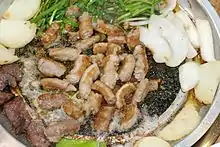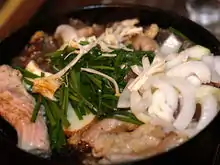Gopchang
Gopchang[2] (Hangul: 곱창) can refer to the small intestines of cattle (or big intestines of pig) or to a gui (grilled dish) made of the small intestines.[1][2] The latter is also called gopchang-gui (곱창구이; "grilled intestines"). The tube-shaped offal is chewy with rich elastic fibers.[3] In Korean cuisine, it is stewed in a hot pot (gopchang-jeongol, 곱창전골), grilled over a barbecue (gopchang-gui), boiled in soup with other intestines (naejang-tang), or made into a sausage (sundae).[4]
 Gopchang-gui (grilled beef small intestines) | |
| Alternative names | Gopchang-gui |
|---|---|
| Type | Gui |
| Place of origin | Korea |
| Associated national cuisine | Korean cuisine |
| Main ingredients | Beef small intestine or pork big intestines |
| 145 kcal (607 kJ)[1] | |
| Similar dishes | Chunchullo |
| Korean name | |
| Hangul | 곱창 |
|---|---|
| Revised Romanization | gopchang |
| McCune–Reischauer | kopch'ang |
| IPA | [kop̚.tɕʰaŋ] |
In the past, gopchang was a popular, nutritious, and cheap dish for the general public.[5] Rich in iron and vitamins, it was served as a health supplement for improving a weak constitution, recovering patients, and postpartum depression.[5] Today, gopchang is also regarded as a delicacy and is more expensive than the regular meat of the same weight.[5] It is a popular anju (food served and eaten with soju), as it helps break down alcohol.[6] Gopchang is an exotic food for foreigners. but It is also one of the most popular foods to try in Korea.[7]
Preparation
The intestines are cleaned thoroughly, rubbed with wheat flour and coarse salt, and rinsed several times.[3] The fat is trimmed off, and the cleaned gopchang is soaked in water to remove any traces of blood.[1] Garlic, ginger, onion, cooking wine, black pepper, and Korean pepper are common marinating ingredients, mainly used for eliminating any unpleasant odors and tenderizing the meat of gopchang.[1][3]
Ingredients for gopchang-gui marinade are juiced, rather than minced, so that they don't burn during the grilling process.[8] Common ingredients include soy sauce, gochutgaru (chili powder), mullyeot (rice syrup), cheongju (rice wine), onion juice, apple juice, garlic juice, scallion juice, and ginger juice.[8]
The gopchang is first marinated in the seasonings and spices, then grilled on a lightly greased pan or griddle.[8] Onions and bell peppers are often grilled together with gopchang.[8] Grilled gopchang is often served dipped in salt and sesame oil.[8] After that, usually Bokkumbab (Hangul: 볶음밥) is cooked with Gopchang oil.
Varieties and similar dishes
Gopchang of pork big intestines is usually called dwaeji-gopchang (돼지곱창; "pig gopchang").
In Korean cuisine, food similar to gopchang prepared with beef blanket tripe is called yang-gopchang (양곱창; "rumen gopchang"),[5] while the one prepared with beef reed tripe is called makchang (막창; "last tripe"),[5] and the one with beef large intestines is called daechang (대창; "big innards").[9]
Internationally, gopchang could be compared to chitterlings (pork's small intestines) or Latin American chunchullo (beef, pork, or lamb's small intestines). The Spanish/Portuguese term tripas or the English tripe also occasionally referred to as small beef's intestines, attesting to the practice of consuming animal intestines as a truly worldwide phenomenon.
Some foods have tripe in their dishes, such as stir-fried tripe and gopchang jeongol.
Gallery
 Uncooked gopchang prepared to cook on grill
Uncooked gopchang prepared to cook on grill Yangnyeom-gopchang (marinated gopchang)
Yangnyeom-gopchang (marinated gopchang) Gopchang-bokkeum (stir-fried gopchang)
Gopchang-bokkeum (stir-fried gopchang) Gopchang-jeongol (gopchang hot pot)
Gopchang-jeongol (gopchang hot pot)
References
- 주, 선태; 김, 갑돈 (2012). Gogi sucheop 고기 수첩 (in Korean). Seoul: Woodumji. pp. 106–107. ISBN 978-89-6754-000-5 – via Naver.
- "gopchang" 곱창. Standard Korean Language Dictionary (in Korean). National Institute of Korean Language. Retrieved 9 May 2017.
- "gopchang" 곱창. Doopedia (in Korean). Doosan Corporation. Retrieved 9 May 2017.
- Montgomery, Charles (15 May 2014). "The 10 Most Bizarre Korean Foods To Try Out". 10 Magazine. Retrieved 9 May 2017.
- "gopchang gui" [Grilled Beef Tripe]. Korean Food Foundation. Retrieved 27 April 2017.
- Yoon, So-yeon (19 December 2016). "Bottomless eats, endless headache". Korea JoongAng Daily. Retrieved 9 May 2017.
- Herald, The Korea (2010-10-04). "Top seven exotic Korean dishes for foreigners". www.koreaherald.com. Retrieved 2019-03-24.
- "gopchang-gui" 곱창구이. Doopedia (in Korean). Doosan Corporation. Retrieved 9 May 2017.
- "daechang" 대창. Standard Korean Language Dictionary (in Korean). National Institute of Korean Language. Retrieved 9 May 2017.
